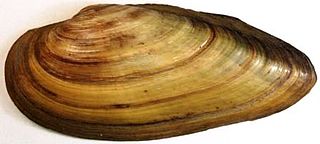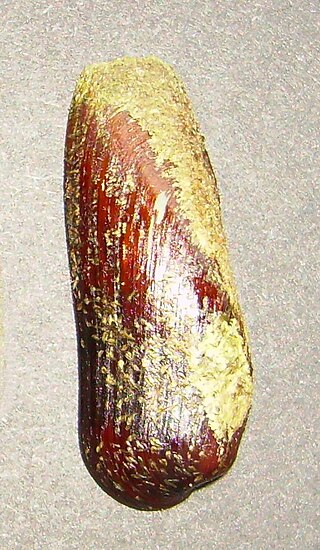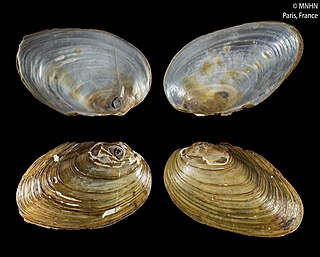| Lioberus | |
|---|---|
 | |
| Lioberus castanea | |
| Scientific classification | |
| Domain: | Eukaryota |
| Kingdom: | Animalia |
| Phylum: | Mollusca |
| Class: | Bivalvia |
| Order: | Mytilida |
| Family: | Mytilidae |
| Genus: | Lioberus Dall, 1898 |
| Synonyms | |
| |
| Lioberus | |
|---|---|
 | |
| Lioberus castanea | |
| Scientific classification | |
| Domain: | Eukaryota |
| Kingdom: | Animalia |
| Phylum: | Mollusca |
| Class: | Bivalvia |
| Order: | Mytilida |
| Family: | Mytilidae |
| Genus: | Lioberus Dall, 1898 |
| Synonyms | |
| |
The following species are recognised in the genus Lioberus: [2]

Mussel is the common name used for members of several families of bivalve molluscs, from saltwater and freshwater habitats. These groups have in common a shell whose outline is elongated and asymmetrical compared with other edible clams, which are often more or less rounded or oval.

The zebra mussel is a small freshwater mussel. The species originates from the lakes of southern Russia and Ukraine, but has been accidentally introduced to numerous other areas and has become an invasive species in many countries worldwide. Since the 1980s, the species has invaded the Great Lakes, Hudson River, and Lake Travis. The adverse effects of dreissenid mussels on freshwater systems have led to their ranking as one of the world's most invasive aquatic species.[https://doi.org/10.20944/preprints202310.0535.v1, encyclopedia of biological invasions ISBN: 9780520264212]
The Dreissenidae are a family of small freshwater mussels, aquatic bivalve molluscs. They attach themselves to stones or to any other hard surface using a byssus. The shells of these bivalves are shaped somewhat like those of true mussels, and they also attach themselves to a hard substrate using a byssus, however this group is not at all closely related to true mussels, being more closely related to the venus clams (Veneridae).

The Unionidae are a family of freshwater mussels, the largest in the order Unionida, the bivalve molluscs sometimes known as river mussels, or simply as unionids.

Unio is a genus of medium-sized freshwater mussels, aquatic bivalve mollusks in the family Unionidae, the river mussels. They are found throughout Europe, Africa, and the Middle East, with some species introduced to East Asia. Fossil species are also known from the Jurassic of North America.

Anodonta is a genus of freshwater mussels in the family Unionidae, the river mussels.

Lithophaga, the date mussels, are a genus of medium-sized marine bivalve molluscs in the family Mytilidae. Some of the earliest fossil Lithophaga shells have been found in Mesozoic rocks from the Alps and from Vancouver Island.

Cumberlandia monodonta is a freshwater mussel endemic to the United States. Currently, C. monodonta is listed as an endangered species by the U.S. Fish and Wildlife Service and the International Union for Conservation of Nature.

Epioblasma is a North American genus of freshwater mussels, aquatic bivalve mollusks in the family Unionidae, the river mussels. Most of the species in this genus have been lost in modern times, and the entire genus is threatened with the possibility of extinction.

Sagittunio nasutus, the eastern pondmussel, is a species of freshwater mussel in the family Unionidae, the river mussels.

Ligumia is a genus of freshwater mussels, aquatic bivalve mollusks in the family Unionidae.

Potamilus is a genus of freshwater mussels, aquatic bivalve mollusks in the family Unionidae, the river mussels.

Pyganodon is a genus of freshwater mussels, aquatic bivalve mollusks in the subfamily Unioninae of the family Unionidae, the river mussels.

Mytilus is a cosmopolitan genus of medium to large-sized edible, mainly saltwater mussels, marine bivalve molluscs in the family Mytilidae.

Odostomia is the most speciose genus of minute sea snails, pyramidellid gastropod mollusks. This genus is placed in the family Pyramidellidae in the subfamily Odostomiinae. There are several hundred species in this diverse genus

Brachidontes is a genus of mussels in the family Mytilidae.
Pseudoklossia is a genus in the phylum Apicomplexa. Species in this genus infect marine molluscs, although one species infects in an ascidian worm. The life cycle is heteroxenous.
Uniomerus is a genus of freshwater mussels, aquatic bivalve mollusks in the family Unionidae, the river mussels.

Sagittunio is a genus of freshwater mussels, aquatic bivalve mollusks in the family Unionidae.

Ambleminae is a subfamily of freshwater mussel in the family Unionidae. They are found throughout much of eastern North America south to Central America, although fossils are also known from Siberia. Some species have also been introduced to East Asia. They are the most speciose radiation of the Unionidae, with more than 300 species.